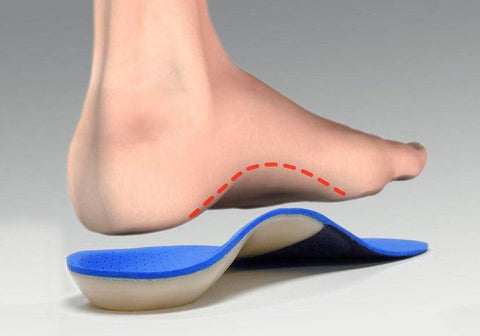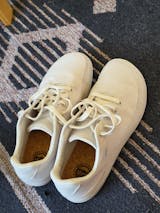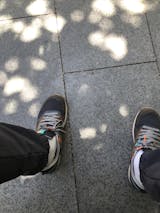
If you were to look out for a pair of running shoes, you'd find most of them with thick cushioning on the soles, raised heels, narrow toe-boxes, some form of arch support, and breathable material. While this particular design is recommended by ‘leading’ shoe brands and some podiatrists, especially if you are treating things like shin splints or plantar fasciitis, it isn't entirely necessary.
With that said, if you do require legitimate support due to some kind of dysfunction, or maybe just reinforcement even, you should check with a licensed medical practitioner, and get appropriate treatment and advice on the best type of shoe to wear. Beyond this, if you are being recommended shoe designs of this nature for regular use, it is most likely a bad idea.
Do Our Feet Require Arch Support?

With all things considered, the short answer is no. That's right, contrary to popular belief, your feet don't require all the extra support that shoe brands claim they do. While the concern of fallen arches is very real, the idea of adding support under your arches is, in fact, an ironic thing to do.
This support reduces the stress the arch of your foot endures and, in turn, the amount of necessity for the muscles in your arch to flex. Since the arch isn't getting much use, it then tends to weaken over time. As this occurs, you begin to rely more and more on wearing shoes just for the basic functioning of your feet. That is why when you switch to a pair of shoes that doesn't quite fit this design, you feel a significant difference.
It's important to note that early in life, children all have flat feet that slowly develop to form their arches, and increase strength in the muscles and bones as they grow. Since your feet absorb shock from the ground, and transfer that energy to the legs for the sake of forward motion, the more time a child spends barefoot, the more likely they are to have stronger feet.
Now, while supportive shoes don't influence whether or not you develop arches, they do influence how fast those arches develop, and to what extent. The problem with this is that children are being given supportive shoes right from when they are toddlers, therefore limiting the strength in their feet. To prove this, studies have found that the odds of deformities like bunions and flat feet are far less common in people who spend more time barefoot rather than in supportive shoes. What’s more, injuries in your feet are more likely to occur for people who use supportive shoes regularly. This is elaborated by the fact that your feet have better pliability being barefoot, since there's no restrictions on their movement. As your toes spread better, you have better grip and balance, and since your arch is taller and stronger, taking a step is easier and less stressful on your legs.
What to Expect When Switching to Shoes Without Arch Support

If you've attempted to switch to shoes without any type of arch support, or tried walking barefoot for the first time in many years, you've probably endured some pain or discomfort, and come to the conclusion that you do, in fact, need support. This couldn't be further away from the truth, and it's important to understand why.
As you wear shoes for extended periods of time, and as you get used to the support and cushioning, your feet tend to weaken since they don't need to work so hard to move. Along with this, your gait and technique, whether walking, running, or even how you stand for that matter, is affected by the shoes you wear. Therefore, switching to barefoot shoes after your feet have become accustomed to this excess padding is naturally going to cause some form of discomfort initially.
As to why this is the case is rather simple. As mentioned earlier, when you get used to the support in modern shoes, your arches begin to weaken, and you tend to rely on that support as time goes by. When you're relying on this support, the likelihood of your foot rolling inwards with each step goes up. This is purely because your foot's arch collapses, and you now have flat feet. Moreover, since you are used to the support under the arch, when you take a step, your weight falls on the inside of your foot, further causing stress on the ankle. This increases the risk of injury as you could lose your balance or footing easily.
How to Address Problems When Transitioning to Barefoot Shoes
As you begin your attempts to switch to less supports, it's important to remember that you are most likely going to experience a bit of discomfort or pain. For many, this transition is not easy, and takes time. It's the equivalent of not working out a day in your life, only to attempt deadlifting on your first day at the gym. The repercussions will be horrible for your body. This is why people are often discouraged from transitioning to barefoot or less supportive shoes.
With that in mind, do yourself a favour and approach a physiotherapist before attempting any changes. Rely on the exercises they can provide for training your feet to respond better and build strength. As you go through these exercises, walking barefoot, or with minimalist shoes, will suddenly become easier over time, and you can slowly, at your pace, complete the transition to barefoot shoes and achieve the strength your feet were meant to have.
Thanks to more therapists and medical practitioners recognising the problems with modern shoes, more people are encouraging the use of minimalist shoes. Since our feet were meant to be strong and functional on their own, without any arch support, more brands are creating natural footwear that is shaped like the human primal foot, and do away with the design elements that lead to foot deformities and dysfunction. To conclude, arch support is NOT absolutely necessary in footwear, and is purely situational, depending on your health.
At bprimal, we work with shoemakers and brands who create natural footwear that are made to encourage better foot health by repairing the damage caused by long term use of modern shoes. These minimalist or healthy footwear alternatives ensure proper preservation of one’s natural foot shape and function thanks to their inclusion of all the design specifics needed to achieve optimal foot health. Some of these features include wide toe boxes, slim and flexible soles, and no heel elevation. Our involvement and interaction with people who create and promote products that help individuals fix their foot problems has also inspired us to spread crucial awareness – relating to prioritising foot health as told by the experts – via our blog. Learn More - check out bprimal educational articles here, and browse through the different brands and collections of natural footwear and foot health restoration products we carry.
DISCLAIMER:
The above content is for educational or informational purposes only and is not intended to replace or augment professional medical instruction, diagnosis, or treatment. Read the full Terms and Conditions & Disclaimer here.
























